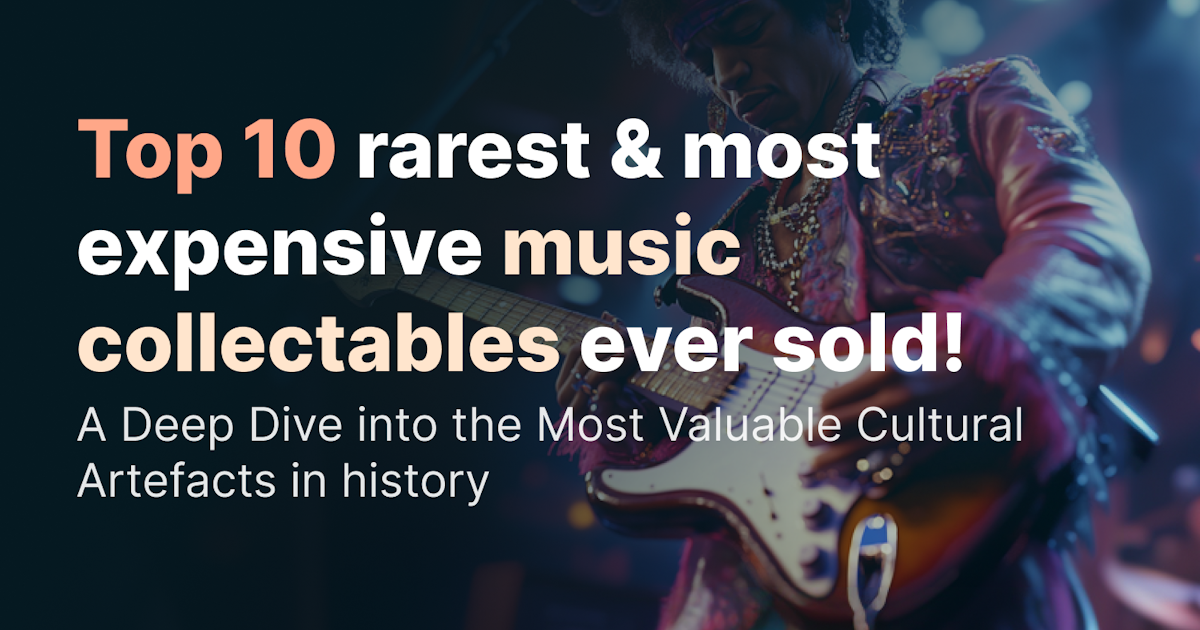This website uses cookies
We use cookies to personalise content and ads, to provide social media features and to analyse our traffic. We also share information about your use of our site with our social media, advertising and analytics partners who may combine it with other information that you’ve provided to them or that they’ve collected from your use of their services.
Cookie Policy
What are cookies?
A cookie is a small text file that a website stores on your computer or mobile device when you visit the site.
- First party cookies are cookies set by the website you're visiting. Only that website can read them. In addition, a website might potentially use external services, which also set their own cookies, known as third-party cookies.
- Persistent cookies are cookies saved on your computer and that are not deleted automatically when you quit your browser, unlike a session cookie, which is deleted when you quit your browser.
Every time you visit our websites, you will be prompted to accept or refuse cookies. The purpose is to enable the site to remember your preferences (such as user name, language, etc.) for a certain period of time. That way, you don't have to re-enter them when browsing around the site during the same visit.
Cookies can also be used to establish anonymised statistics about the browsing experience on our sites.
How do we use cookies?
Currently, there are four types of cookies that may be generated as you browse our site: Strictly Necessary, Statistics, Preference and Marketing cookies.
1. Strictly Necessary Cookies
These cookies are essential for you to browse the website and use its features, such as accessing secure areas of the site. Cookies that allow web shops to hold your items in your cart while you are shopping online are an example of strictly necessary cookies. These cookies will generally be first-party session cookies. While it is not required to obtain consent for these cookies, what they do and why they are necessary are explained in the table below.
How do I control Strictly Necessary Cookies?
You can use your browser settings to control whether or not we set session cookies. More information on your browser settings is provided at the bottom of this page.
Please be aware that these cookies are critical to the efficient working of the site. If you choose to disable these cookies from this site, the functionality of the site may be greatly reduced.
2. Statistics Cookies
Also known as "performance cookies," these cookies collect information about how you use a website, like which pages you visited and which links you clicked on. None of this information can be used to identify you. It is all aggregated and, therefore, anonymized. Their sole purpose is to improve website functions. This includes cookies from third-party analytics services as long as the cookies are for the exclusive use of the owner of the website visited.
Statistical information is used in reports and to improve our site. For example, we have used analytics data to add, remove or change features of the site based on how popular they are with users.
We track, for example:
- the numbers of visitors to individual pages;
- when pages were visited;
- how long users stayed on the page;
- the IP address of the user of the website;
- the page they came from;
- technical data about the device being used to browse the site (such as browser and operating system version, and display size) — we use this data to ensure that the technology our site uses is appropriate for the majority of our users, and how best to display the site for users who have less capable browsers.
More information about Statistics cookies
We use cookies from different partners including Google to provide our analytics data. You can read more about how Google Analytics treats your data on their web site. You can also read Google's full privacy policy.
How do I control Statistics cookies?
Google provides a tool to opt-out of Google Analytics. This is available for all modern browsers in the form of a browser plugin. Additionally, you can control how cookies are set using your browser settings.
3. Preference cookies
Also known as "functionality cookies," these cookies allow a website to remember choices you have made in the past, like what language you prefer, whether you have accepted our cookie policy, what region you would like weather reports for, or what your user name and password are so you can automatically log in.
4. Marketing cookies
The advertisements you see displayed on this, and other, sites are generated by third parties. These services may use their own anonymous cookies to track how many times a particular ad has been displayed to you and may track your visits to other sites where their ads are displayed. Please note that advertisers can only track visits to sites which display their ads or other content. This tracking is anonymous, meaning that they do not identify who is viewing which ads.
Tracking in this manner allows advertisers to show you ads that are more likely to be interesting to you, and also limit the number of times you see the same ad across a wide number of sites. As an example of how advertisers operate, if you recently researched holidays, adverts for holiday operators may subsequently appear on our sites.
We do not have access to, or control over, these third party cookies; nor can we view the data held by these advertisers. Online advertisers provide ways for you to opt-out of your browsing being tracked. More information about the advertisers we use, and how to opt-out, is provided below.
Youtube
We display clips from Youtube related to our purchase opportunities. You can view Youtubes's privacy policy on their website. This page also allows you to control what cookies YouTube saves on your computer.
We work with Google to optimise how Google ads are displayed. You can discover how Google protects your privacy relating to ads at its privacy policy.
Cookie Table of our cookies
Cookies you may see used on konvi.app
| Cookie name | Default expiration time | Purpose | Description |
|---|---|---|---|
| _fbp | 3 months | Marketing cookies | Facebook: to store and track visits across websites. |
| _ga | 2 years | Statistics cookies | Google Analytics: to store and count pageviews. |
| _gat_UA-* | 1 minute | Statistics cookies | Google Analytics: functional |
| _gid | 1 day | Statistics cookies | Google Analytics: to store and count pageviews. |
| _iub_cs-* | 1 year | Preferences cookies | iubenda: to store cookie consent preferences. |
| euconsent-v2 | 1 year | Preferences cookies | To store cookie consent preferences. |
| referrerReferralId | 1 browser session | Strictly necessary cookies | Track user referrals |
| t_gid | 1 year | Marketing cookies | Taboola: assigns a unique User ID that allows Taboola to recommend specific advertisements and content to this user |
| APISID | 2 years | Marketing cookies | Youtube: Google Ads Optimization |
| HSID | 2 years | Marketing cookies | Youtube: to provide fraud prevention |
| LOGIN_INFO | 2 years | Marketing cookies | Youtube: to store and track visits across websites. |
| PREF | 2 years | Marketing cookies | Youtube: to store and track visits across websites. |
| SAPISID | 2 years | Marketing cookies | Youtube: Google Ads Optimization |
| SID | 2 years | Marketing cookies | Youtube: to provide ad delivery or retargeting, provide fraud prevention. |
| SIDCC | 1 year | Marketing cookies | Youtube: to provide ad delivery or retargeting, provide fraud prevention. |
| SSID | 2 years | Marketing cookies | Youtube: to provide ad delivery or retargeting, provide fraud prevention. |
| VISITOR_INFO1_LIVE | 1 year | Strictly necessary cookies | Youtube: to provide bandwidth estimations. |
| YSC | 1 browser session | Marketing cookies | Youtube: to store a unique user ID. |
| __Secure-1PAPISID | 2 years | Marketing cookies | Youtube: Google Ads Optimization |
| __Secure-1PSID | 2 years | Marketing cookies | Youtube: to provide ad delivery or retargeting, provide fraud prevention. |
| __Secure-3PAPISID | 2 years | Marketing cookies | Youtube: Google Ads Optimization |
| __Secure-3PSID | 2 years | Marketing cookies | Youtube: to provide ad delivery or retargeting, provide fraud prevention. |
| __Secure-3PSIDCC | 1 year | Marketing cookies | Youtube: to provide ad delivery or retargeting, provide fraud prevention. |
| IDE | 1.5 years | Marketing cookies | doubleclick: serving targeted advertisements that are relevant to the user across the web. |
| RUL | 1 year | Marketing cookies | doubleclick: serving targeted advertisements that are relevant to the user across the web. |
| variant | 1 browser session | Strictly necessary cookies | For providing targeted content to users |
| cookie_consent | 1 year | Strictly necessary cookies | For persisting cookie consent |
| 1P_JAR | 1 month | Marketing cookies | Google: optimize advertising, to provide ads relevant to users |
| NID | 1 month | Marketing cookies | Google: to provide ad delivery or retargeting, store user preferences |
Removing cookies from your device
You can delete all cookies that are already on your device by clearing the browsing history of your browser. This will remove all cookies from all websites you have visited.
Be aware though that you may also lose some saved information (e.g. saved login details, site preferences).
Managing site-specific cookies
For more detailed control over site-specific cookies, check the privacy and cookie settings in your preferred browser
Blocking cookies
You can set most modern browsers to prevent any cookies being placed on your device, but you may then have to manually adjust some preferences every time you visit a site/page. And some services and functionalities may not work properly at all (e.g. profile logging-in).
Further help
If you still have any concerns relating to our use of cookies, please contact us at support@konvi.app

10 rarest and most expensive music collectables ever sold!
Nikkan Navidi•5.5.2025
The global market for music memorabilia and particularly rock-related collectables has become one of the most culturally resonant and financially dynamic corners of the alternative investment world. While luxury watches or fine art tend to dominate headlines in traditional wealth circles, rare guitars, handwritten lyrics, iconic stage instruments, and even automobiles owned by legendary musicians are quietly fetching millions at auction.
What makes these items valuable is their material rarity and their deep connection to popular culture and generational identity. A guitar played by Jimi Hendrix, a piano used by John Lennon, or handwritten lyrics by Bob Dylan are historically significant and they are culturally iconic artefacts with embedded emotional meaning for millions of fans around the world.
Rock memorabilia derives its value from several intertwined factors:
- Historical provenance — who owned it, when it was used, and in what context
- Rarity — often one-of-one or extremely limited in surviving examples
- Condition and preservation — especially for instruments, vehicles, and autographed items
- Cultural impact — items associated with pivotal moments in music history, such as Woodstock or MTV Unplugged sessions
- Market visibility — high-profile auction results have helped solidify these items as legitimate alternative investments
In recent years, auction houses like Christie’s, Julien’s, and Sotheby’s have hosted record-breaking sales of rock memorabilia, increasingly drawing interest from serious collectors and investors alike. This surge in demand has also coincided with the rise of fractional investing platforms, allowing a broader audience to gain exposure to high-profile cultural assets once reserved for private buyers.
In this article, we’ll highlight ten of the rarest and most expensive rock collectables ever sold, each of them verifiably auctioned, culturally significant, and illustrative of why this niche market is attracting growing attention from investors globally.
What Makes Rock Memorabilia So Valuable?
The value of rock memorabilia is rooted in more than nostalgia — it reflects a combination of historical significance, cultural symbolism, and scarcity. Items associated with iconic artists or pivotal moments in music history often carry profound emotional weight and cross-generational appeal. A guitar played at Woodstock, a handwritten lyric sheet from a breakthrough album, or a jacket worn on stage during a world tour becomes more than a personal object — it becomes a tangible link to the history of modern culture.
What sets these collectables apart is their inherent scarcity. Many are one-of-one artefacts, not by design, but because they were used in unique, irreplicable contexts — such as a legendary performance, a televised interview, or a studio recording that defined a genre. These items gain significance as time passes and the cultural footprint of the artist or event becomes more established. Unlike manufactured limited editions, their value is often tied to spontaneity, documentation, and historical happenstance, which cannot be artificially reproduced.
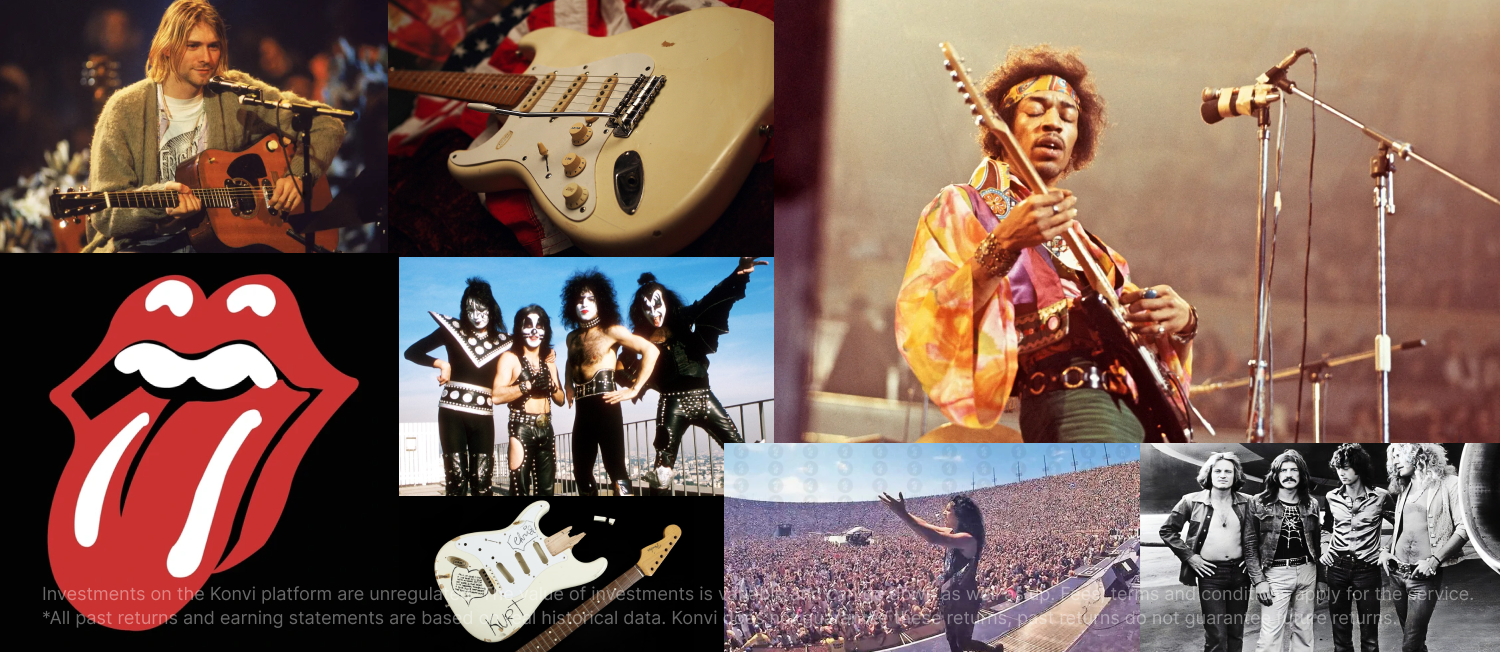
This passage of time only enhances their rarity. As artists pass away, bands disband, or key moments recede into history, the remaining physical artefacts become increasingly scarce — and increasingly valuable. Demand often rises even as supply diminishes, creating market asymmetry that favours long-term appreciation.
From an investment standpoint, these assets also benefit from low correlation to traditional financial markets. Their value isn’t dictated by interest rates or earnings reports, but by cultural relevance, provenance, and collector demand. As such, rock memorabilia can function as a hedge against market volatility, offering diversification benefits within broader portfolios. This combination of cultural capital and investment resilience is why serious collectors and investors alike are giving this asset class a second look.
What Counts as Rock Collectables?
Rock collectables span a wide range of categories, from instruments and stage-used gear to handwritten lyrics, clothing, vehicles, and even personal effects owned or signed by artists. Guitars played by legends like Hendrix or Cobain, original pressing vinyls with band annotations, or concert-worn outfits are considered high-tier assets in this category.
These items fall under what auction houses classify as cultural artefacts, and their eligibility as collectables is generally supported by provenance, condition, and verifiable use. Items linked to historic performances, album recordings, or public appearances often command the highest premiums.
Why Demand for Music Memorabilia Keeps Growing
Interest in music memorabilia continues to grow because of fan-driven demand, as well as due to the broader legitimisation of alternative asset classes. As more high-net-worth individuals, funds, and platforms explore non-traditional investments, cultural assets are gaining prominence for their emotional appeal, tangible nature, and strong historical performance.
In an increasingly digital world, owning something physical, particularly something tied to a culturally influential figure, offers a sense of permanence and identity. With each new auction record, items once seen as fan curiosities are being reframed as culturally significant investments, driving demand and competition among collectors.
1. Elvis Presley’s 1942 Martin D-18 Acoustic Guitar – $1.32 Million
This 1942 Martin D-18 acoustic guitar belonged to Elvis Presley during the early years of his career and was used during his pivotal time at Sun Studios in Memphis. The instrument is considered foundational to the development of rockabilly and early rock’n’roll. Sold for $1.32 million at Guernsey’s Auction House in 2020, it remains one of the most historically significant guitars ever to reach the market.
The guitar’s value is driven by its close association with the formative years of Presley’s career, its visible playwear, and the extensive documentation linking it to early performances and recordings. As one of the few surviving guitars used by Presley before his global breakthrough, its scarcity and cultural significance continue to drive collector and investor demand.
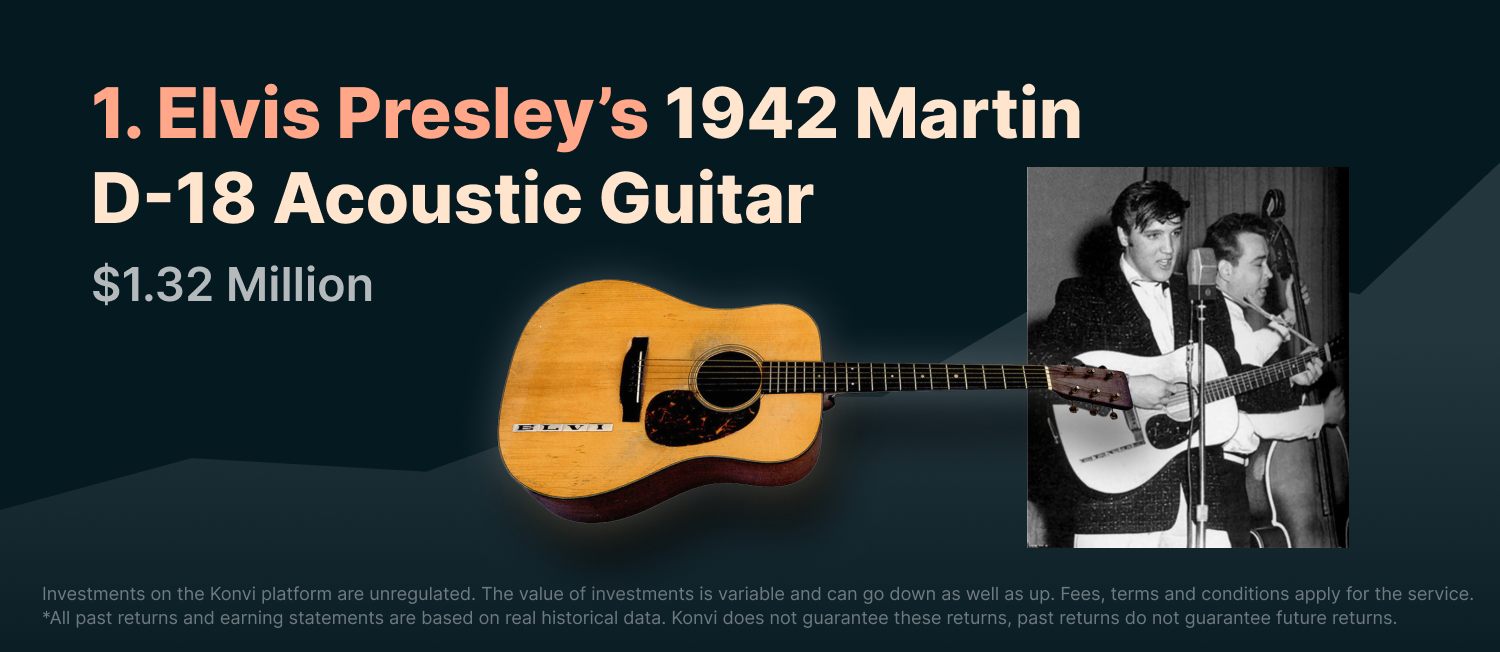
2. Bob Dylan’s Handwritten “Like a Rolling Stone” Lyrics – $2.045 Million
In 2014, Sotheby’s auctioned Bob Dylan’s original, handwritten lyrics for the groundbreaking 1965 anthem “Like a Rolling Stone”. The four-page manuscript sold for $2.045 million, setting a record for the most expensive rock lyrics ever sold.
Composed on hotel stationery, the lyric sheets include revisions, crossed-out lines, and alternate phrases — offering rare insight into Dylan’s creative process. The sale was buoyed by Dylan’s later receipt of the Nobel Prize in Literature, which elevated his reputation not only as a songwriter but as a literary figure of the 20th century. This sale confirms that lyric manuscripts, when tied to historically significant works, are valued as both artistic artefacts and cultural investments.
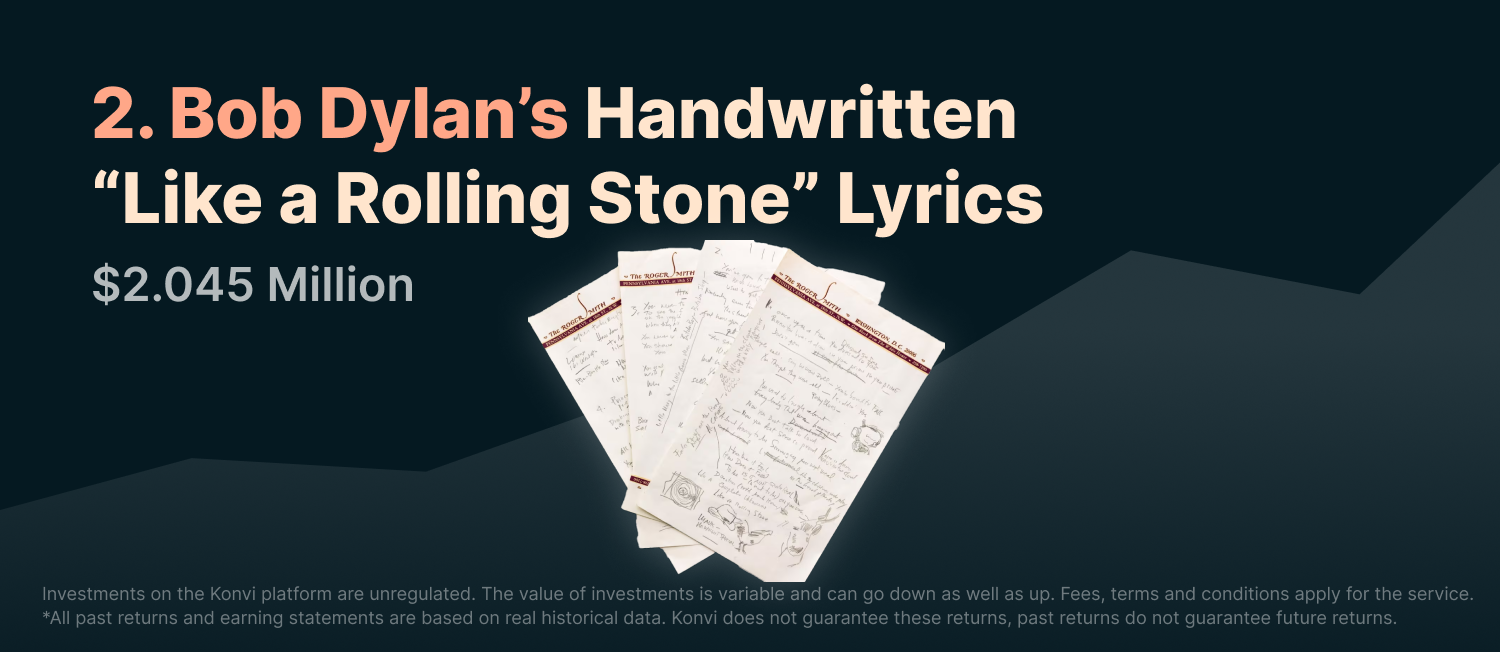
3. John Lennon’s Steinway “Imagine” Piano – $2.1 Million
Sold by Gotta Have It! Collectibles | 2000
The humble brown upright Steinway piano on which John Lennon composed and recorded “Imagine” was sold in 2000 for $2.1 million to musician George Michael. The instrument became a tool of composition and a cultural icon, tied to one of the most enduring anthems of peace and humanitarianism.
Unlike many high-value rock collectables, the piano is modest in appearance, but its historical and emotional resonance far exceeds its physical attributes. George Michael later exhibited it in public as a symbol of peace, further amplifying its cultural significance. The combination of provenance, song legacy, and personal association with Lennon continues to make this one of the most meaningful assets in the memorabilia market.
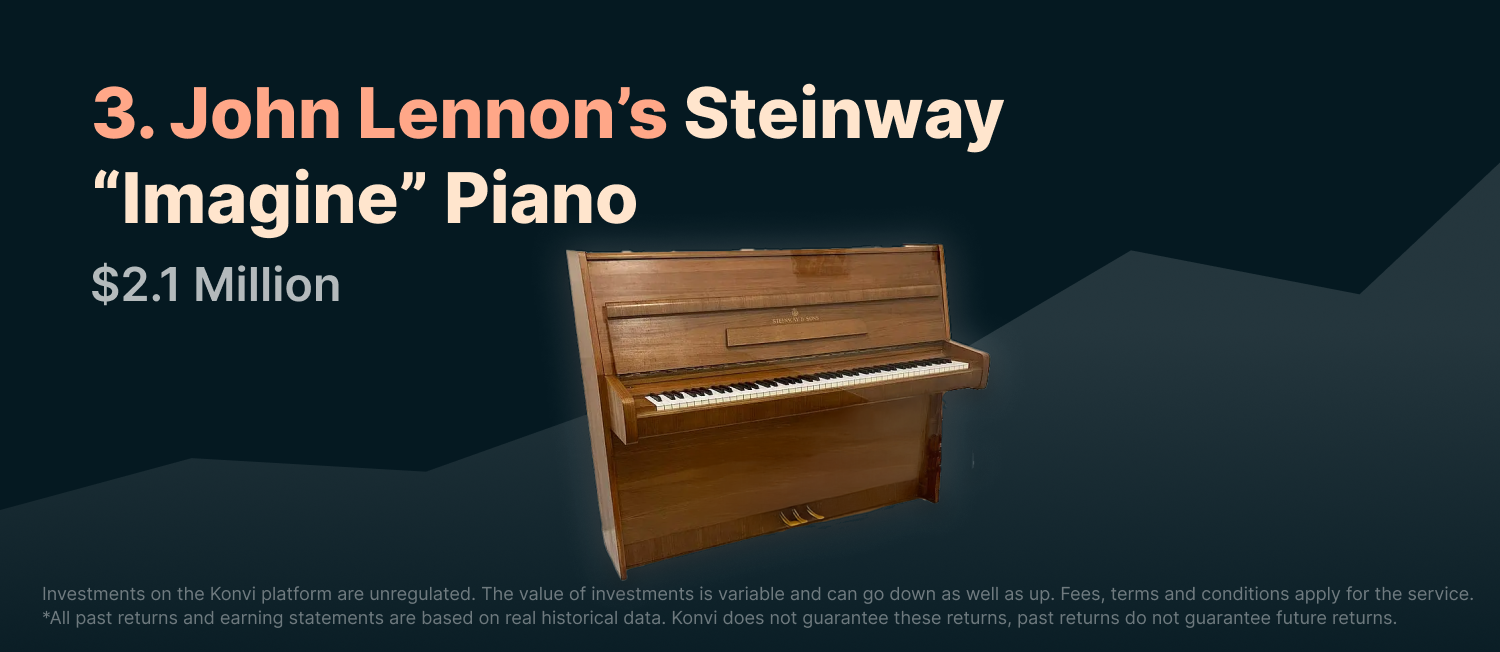
4. Ringo Starr’s Ludwig Drum Kit – $2.2 Million
Sold by Julien’s Auctions | 2015
In 2015, Julien’s Auctions sold Ringo Starr’s Ludwig Oyster Black Pearl drum kit for $2.2 million. This kit was used in over 200 live performances and recording sessions between 1963 and 1964, including appearances on The Ed Sullivan Show and during early Beatles studio recordings.
Purchased by Indianapolis Colts owner Jim Irsay, a well-known collector of music and American cultural artefacts, the kit represents a key piece of The Beatles’ early sonic identity. Its value stems from its central role in the Beatlemania era, its excellent preservation, and the rarity of Beatles-owned instruments reaching the public market. As one of the most recognisable kits in rock history, it has become both a symbol of 1960s pop culture and a secure alternative asset.
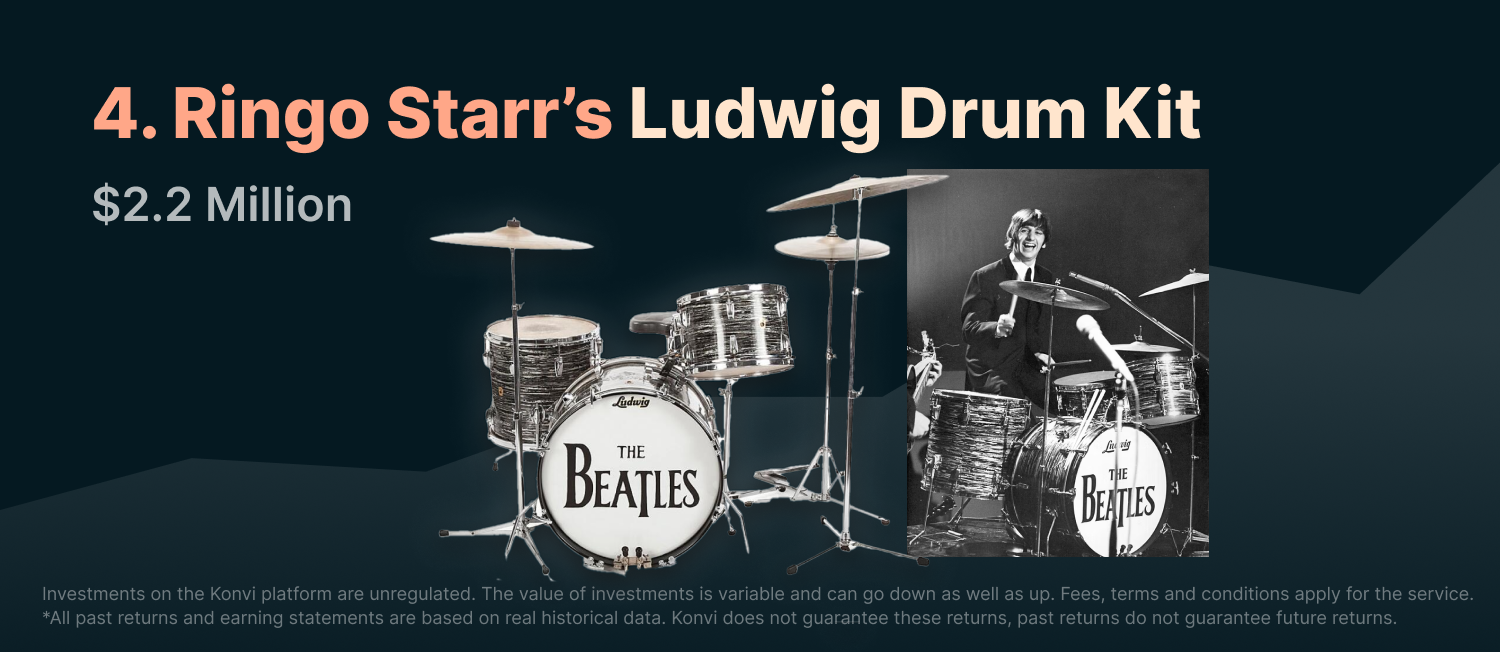
5. John Lennon’s Psychedelic Rolls-Royce Phantom V – $2.299 Million
Sold by Sotheby’s in 1985 for $2.299 million, this custom-painted 1965 Rolls-Royce Phantom V belonged to John Lennon and is among the most visually distinctive vehicles in rock history. Originally a stately black limousine, Lennon had the car repainted in bold, psychedelic motifs in 1967, turning it into a mobile statement of the countercultural movement.
The car has been exhibited globally and is widely recognised in both rock and art circles. Its value lies in its rarity and its visual impact and symbolic status as a bridge between luxury, rebellion, and the evolution of 1960s culture. It remains one of the most expensive pieces of artist-owned memorabilia ever sold at auction.
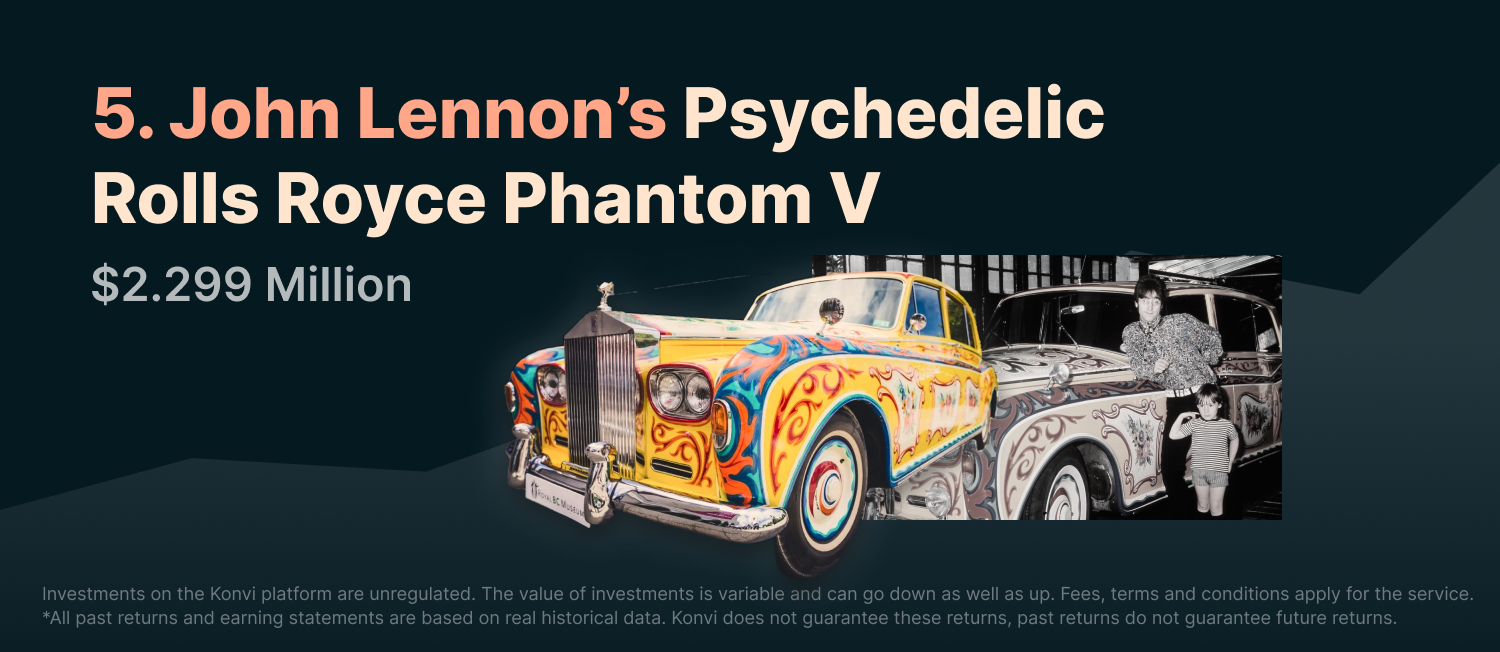
6. John Lennon’s Gibson J-160E Acoustic Guitar – $2.4 Million
Sold by Julien’s Auctions | 2015
Few instruments are as intimately tied to the birth of modern pop music as John Lennon’s Gibson J-160E acoustic guitar. Purchased in 1962 by Lennon for £161 — with a co-signed loan by Beatles manager Brian Epstein — this guitar was used extensively during the early rise of The Beatles, featuring on recordings such as “Love Me Do”, “P.S. I Love You”, and “I Want to Hold Your Hand.”
In late 1963, the guitar mysteriously disappeared. For decades, its whereabouts were unknown, until it resurfaced in 2014 when a California musician, who had unknowingly acquired it at a second-hand store in the 1960s, discovered its origin through an online search. Detailed forensic analysis, including wood grain pattern matching with vintage photographs, confirmed its authenticity.
The guitar went under the hammer at Julien’s Auctions in Beverly Hills in 2015 and sold for $2.41 million, making it the most expensive Beatles instrument ever auctioned at the time. A portion of the proceeds went to the Spirit Foundation, a charitable organisation founded by Lennon and Yoko Ono.
From an investment standpoint, this guitar is a prime example of how lost artefacts with confirmed provenance can appreciate dramatically when rediscovered — especially when linked to foundational moments in cultural history. The sale reinforced Lennon’s enduring influence and highlighted the extreme value placed on singular, emotionally resonant artefacts from music’s most mythologised eras.
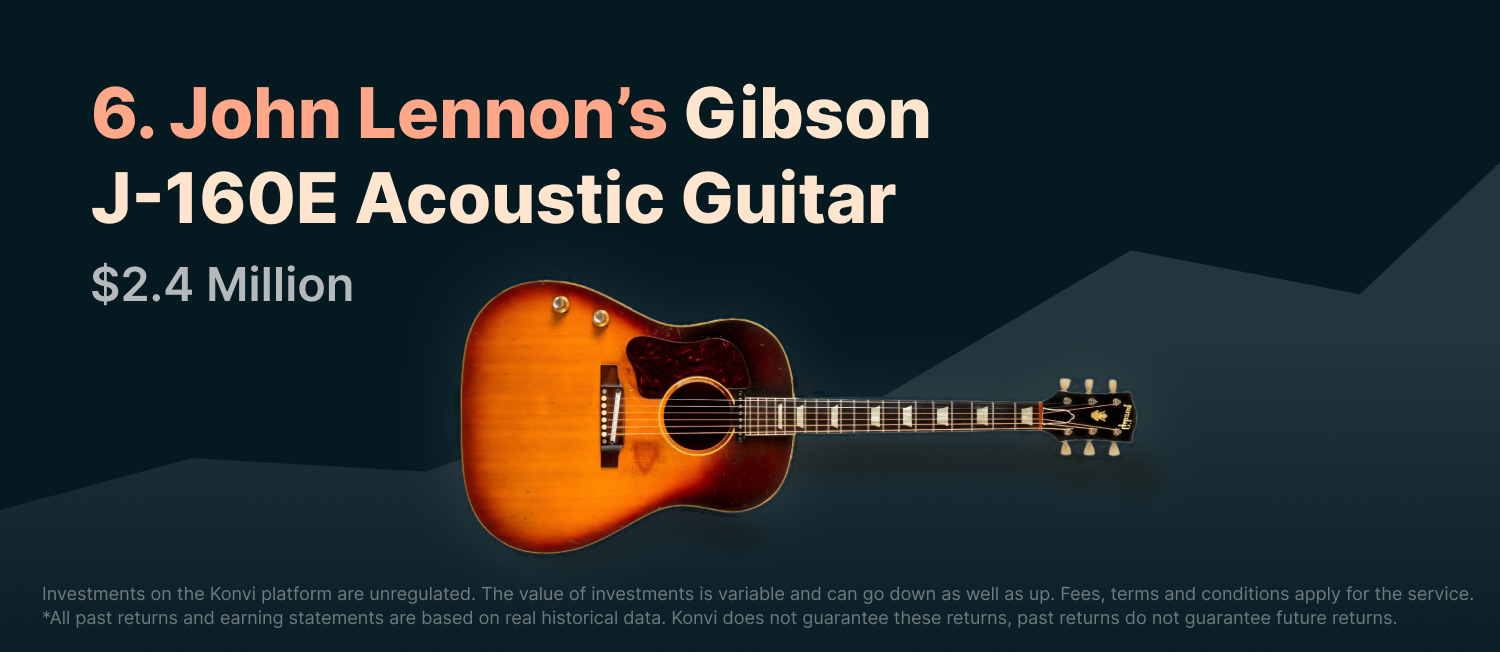
7. Fender Stratocaster “Reach out to Asia” – $2.7 Million
Sold at Charity Auction | Qatar | 2005
While not tied to a single artist, this Fender Stratocaster signed by a constellation of rock legends, including Eric Clapton, Mick Jagger, Jimmy Page, Paul McCartney, and many more, sold for $2.7 million in 2005 at a charity auction in Qatar. The guitar was auctioned to raise funds for the “Reach out to Asia” charity, formed to help tsunami victims following the 2004 Indian Ocean disaster.
Its valuation was unique: not artist use or performance history, but the combined cultural power of more than 20 iconic signatures. Though sometimes debated in pure “memorabilia” rankings due to its multi-ownership nature, it remains one of the highest-valued guitars ever sold.
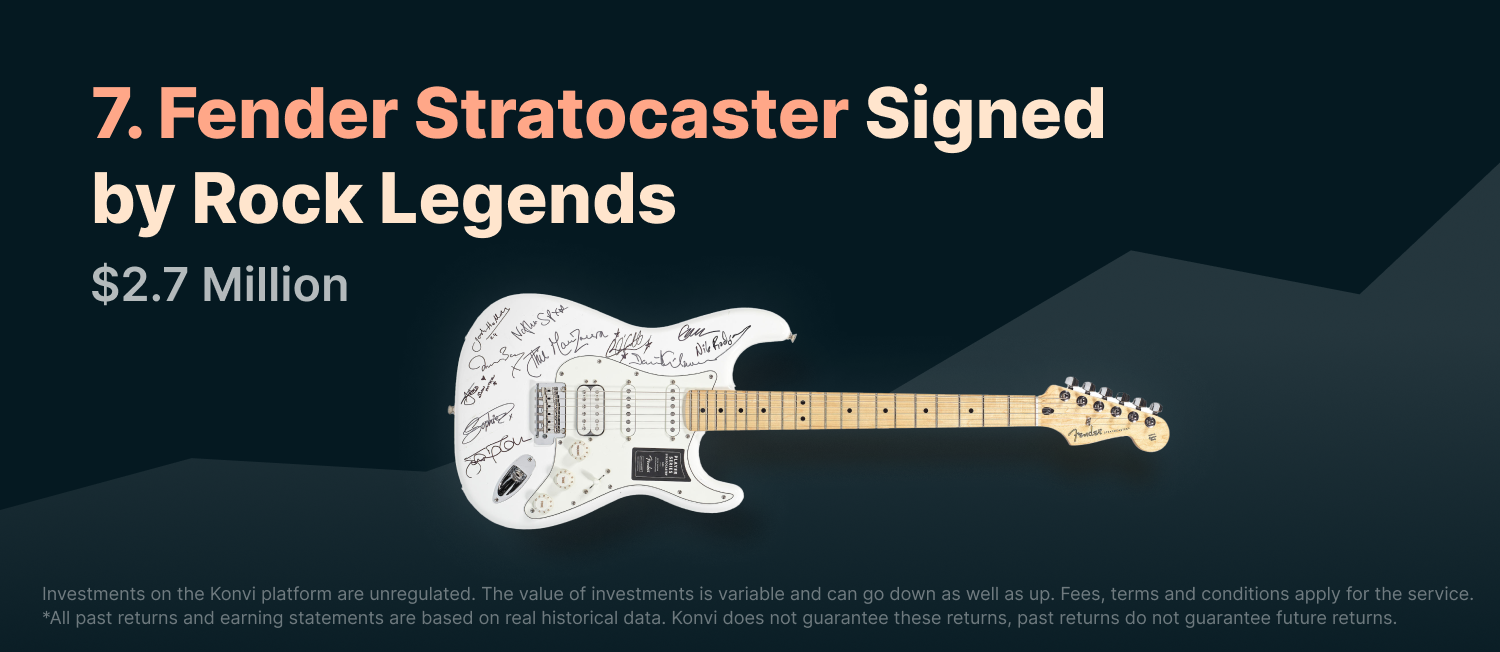
8. David Gilmour’s “Black Strat” Fender Stratocaster – $3.975 Million
Pink Floyd guitarist David Gilmour’s legendary “Black Strat” sold at Christie’s in 2019 for $3.975 million, setting a new benchmark for artist-owned electric guitars. Used extensively between 1970 and 2005, this Stratocaster was integral to the sound of landmark albums like The Dark Side of the Moon, Wish You Were Here, and The Wall.
Its appeal extended beyond technical musicianship — it represented an era of sonic experimentation and progressive rock innovation. The auction benefited charity, further elevating its visibility and media attention. For investors, the Black Strat’s trackable use, cultural weight, and artist provenance made it one of the most institutionally recognisable instruments ever sold.
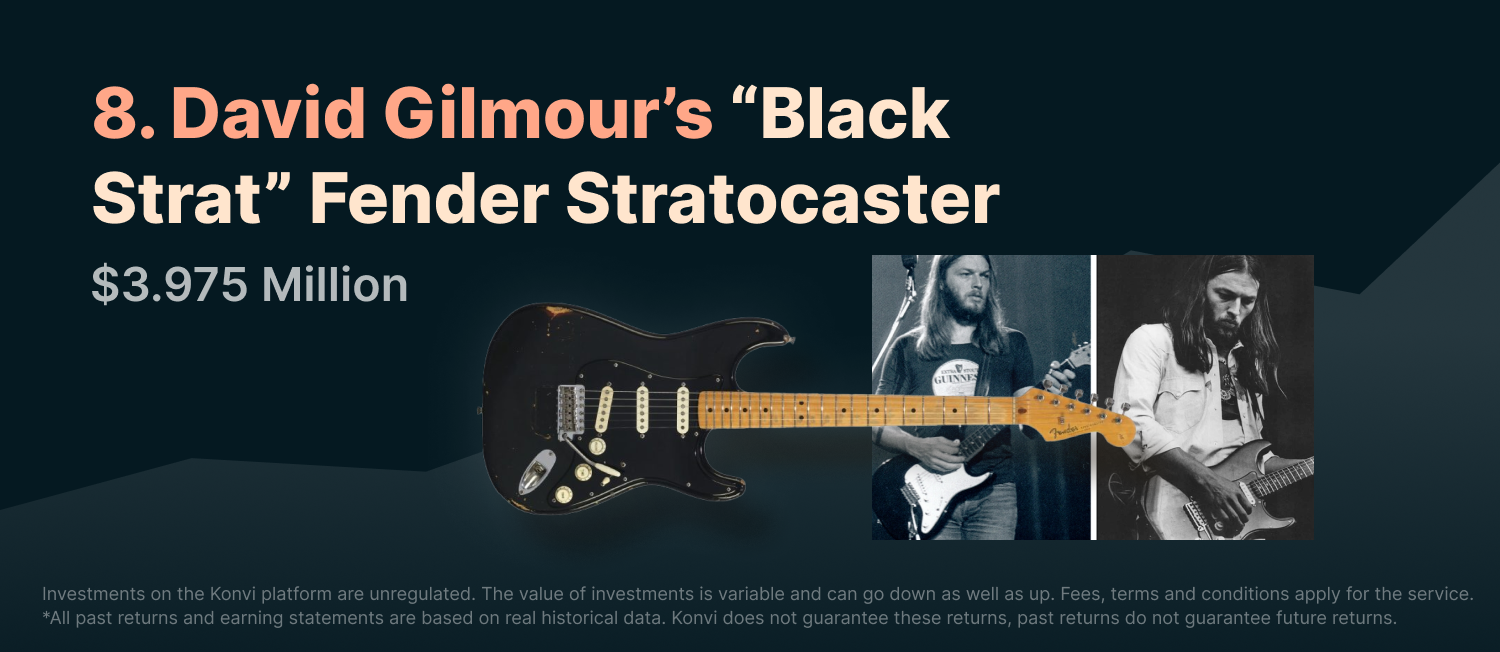
9. Kurt Cobain’s “Smells Like Teen Spirit” Fender Mustang – $4.5 Million
Sold by Julien’s Auctions | 2022
The left-handed Fender Mustang guitar used by Kurt Cobain in the “Smells Like Teen Spirit” video — the defining visual of 1990s grunge — sold for $4.5 million in 2022 through Julien’s Auctions. The sale was part of a larger offering of Nirvana-related memorabilia, and the guitar came with extensive documentation, including photo and video evidence of its use.
Its market value was driven by its connection to Nirvana’s breakout hit and by Cobain’s enduring cult status and the generational shift toward 1990s collectables. Its sale price underscored how iconic music moments tied to visual media can drive collectable demand in ways that transcend traditional memorabilia categories.
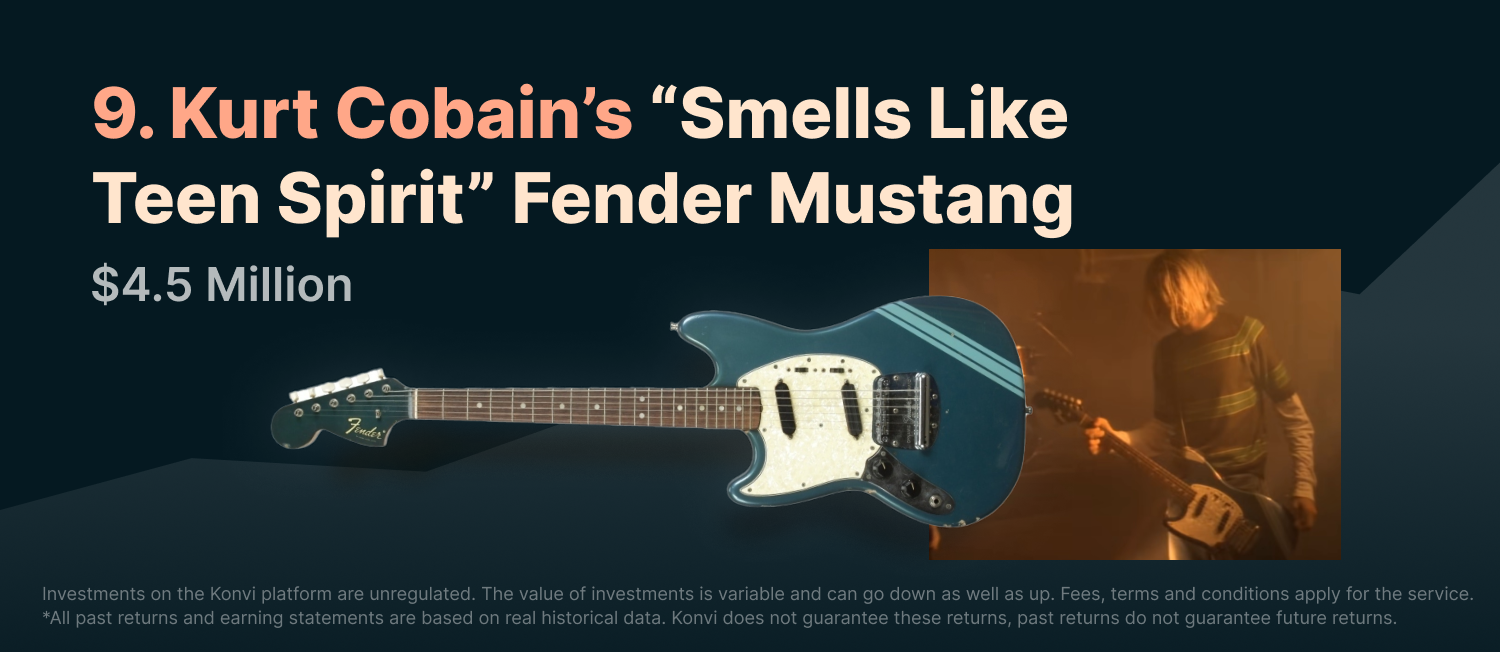
10. Kurt Cobain’s MTV Unplugged Martin D-18E Acoustic Guitar – $6 Million
Sold by Julien’s Auctions | 2020
The crown jewel of rock memorabilia to date remains Kurt Cobain’s 1959 Martin D-18E, played during Nirvana’s MTV Unplugged session in 1993. Sold by Julien’s Auctions in 2020 for $6 million, it set the record for the most expensive guitar — and arguably the most emotionally loaded rock collectable — ever sold.
This performance, recorded just months before Cobain’s death, is widely regarded as one of the most poignant in modern rock history. The guitar’s condition, documentation, and use in that legendary acoustic session contribute to its lasting emotional and market value. Its sale represents a confluence of scarcity, cultural significance, and global nostalgia, making it a benchmark for future music memorabilia valuations.
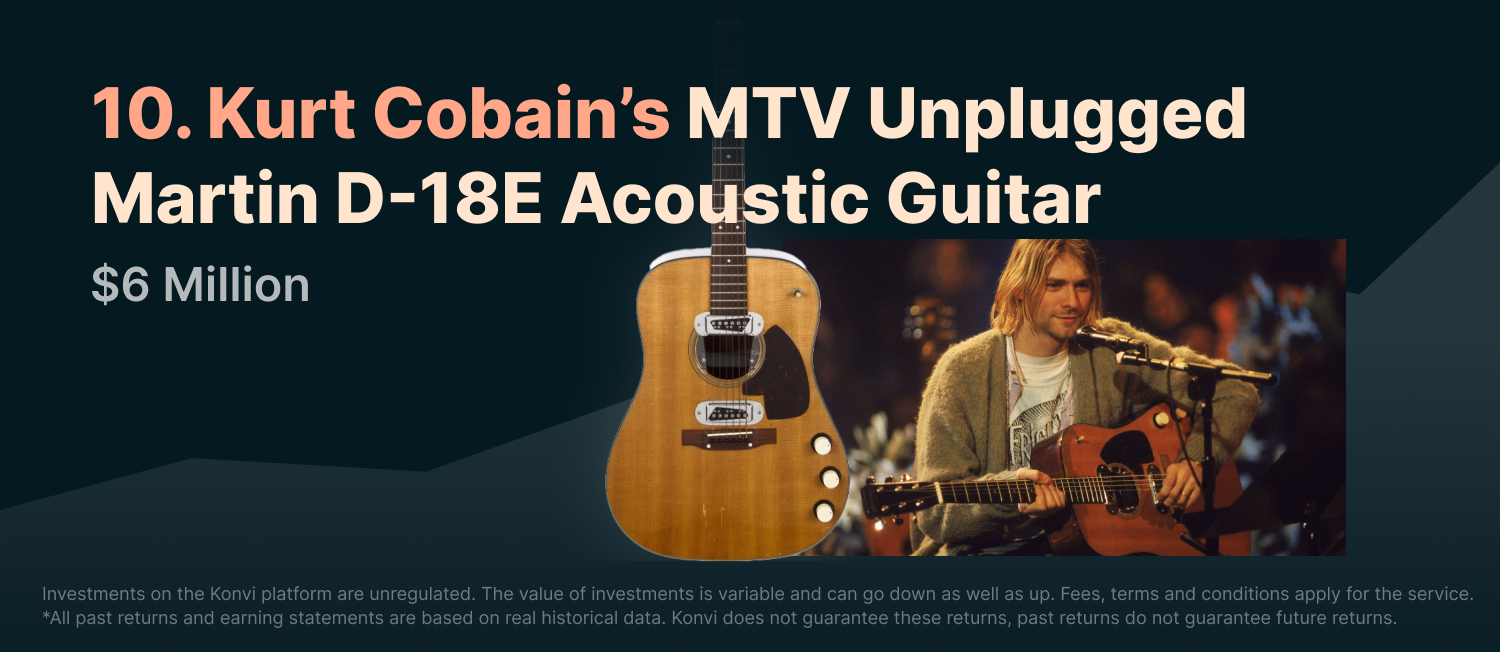
What to Look for When Investing in Rock Memorabilia
Provenance and Documentation Are Non-Negotiable
When it comes to high-value collectables, provenance is everything. Buyers should always seek clear documentation verifying that an item was used, owned, or signed by the artist in question. This includes photographic or video evidence, certificates of authenticity from reputable experts, auction records, and detailed ownership history. The more transparent and traceable the item’s background, the more likely it is to retain or increase its value.
Scarcity and Cultural Relevance Drive Demand
The most valuable items in the memorabilia market are often one-of-a-kind or tied to singular cultural moments. A guitar used in a historic performance, handwritten lyrics from a chart-topping song, or clothing worn during a landmark concert are examples of inherently scarce assets. Even items that were once overlooked can appreciate dramatically as an artist’s legacy evolves or gains renewed public attention. The passage of time tends to make these pieces rarer and more culturally charged, enhancing both emotional and financial value.
Condition and Presentation Matter More Than You Think
While some wear-and-tear can authenticate a stage-used instrument or garment, the item’s overall condition remains critical. Collectables that are well-preserved — especially those that have been properly stored, framed, or professionally conserved — tend to command higher prices. When investing, consider not just the object itself, but how it’s maintained, presented, and protected.
Third-Party Certification Adds Security
Many high-value music artefacts are now accompanied by certifications from well-established organisations or auction houses. These can include DNA tagging for instruments, expert handwriting analysis for lyrics and autographs, and chain-of-custody verification for personal belongings. Avoid relying solely on seller claims, especially in private sales — independent third-party authentication is a vital risk mitigator in this niche market.
Market Timing and Artist Momentum
Finally, timing can play a role in realising returns. Anniversary years, film releases, or major tributes often spark a resurgence of interest in an artist’s legacy. For example, major documentaries or Rock & Roll Hall of Fame inductions can reignite demand. Investors who track cultural cycles and historical moments may find better opportunities to enter or exit the market with stronger margins.
Conclusion: When Culture and Capital Collide
The growing interest in rock memorabilia highlights a broader shift in how investors think about value. As markets become more volatile and cultural capital becomes increasingly quantifiable, collectables like guitars, lyrics, and performance artefacts are being recognised as nostalgic mementoes, as well as serious alternative assets. With proper provenance, verified scarcity, and cultural significance, these items offer more than emotional satisfaction — they offer diversification, tangible value, and historical weight. For those willing to do their due diligence, music memorabilia represents a compelling bridge between passion and portfolio strategy.
